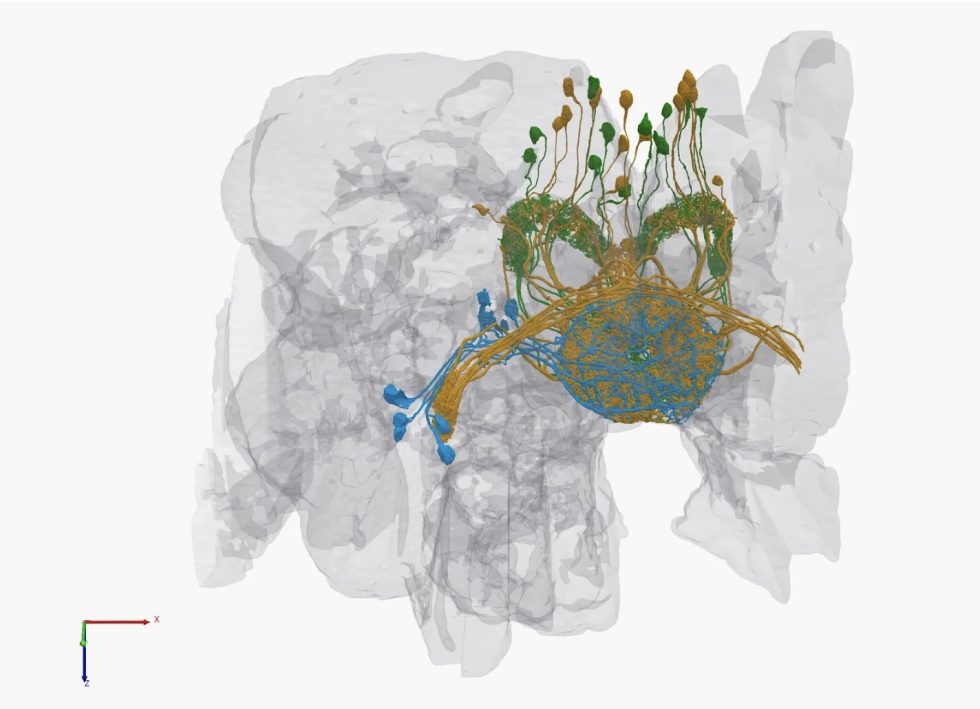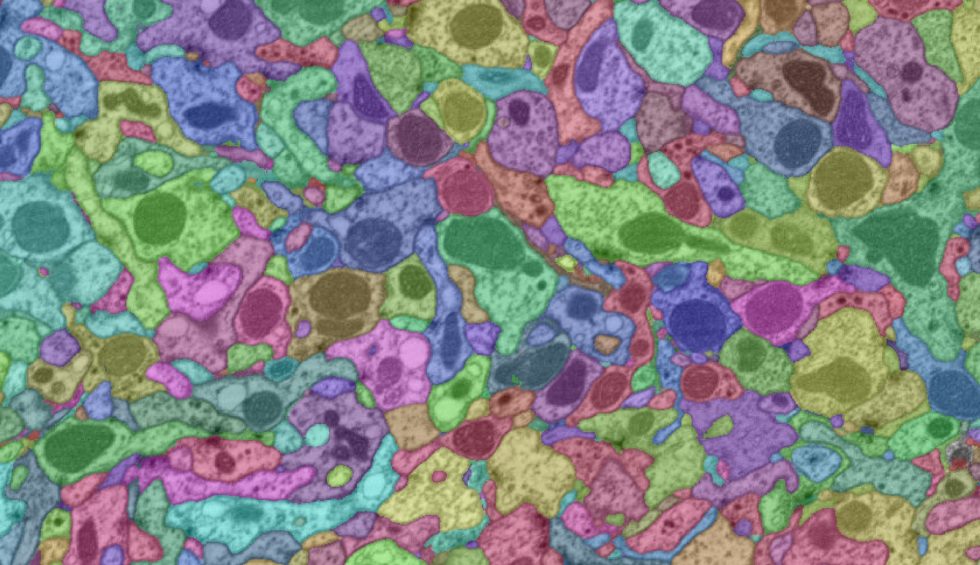When asked whats so special about Drosophila melanogaster, or the common fruit fly, Gerry Rubin quickly gets on a roll. Rubin has poked and prodded flies for decades, including as a leader of the effort to sequence their genome. So permit him to count their merits. Theyre expert navigators, for one, zipping around without crashing into walls. They have great memories too, he adds. Deprived of their senses, they can find their way around a room—much as you, if you were suddenly blindfolded, could probably escape through whichever door you most recently entered.
“Fruit flies are very skillful,” he appraises. And all that skill, although contained in a brain the size of a poppy seed, involves some neural circuitry similar to our own, a product of our distant common ancestor. Thats why, as director of Janelia Research Campus, part of the Howard Hughes Medical Institute, hes spent the last 12 years leading a team thats mapping out the fly brains physical wiring, down to the very last neuron.

Janelia researchers announced a major step in that quest on Wednesday, releasing a wiring diagram of the fly brain that contains 25,000 neurons and the 20 million connections between them. The so-called “connectome” corresponds to the flys hemibrain, a region thats about 250 micrometers across—the size of a dust mite, or the thickness of two strands of hair. Its about a third of the total fly brain, and contains many of the critical regions responsible for memory, navigation, and learning.

Researchers like Rubin believe a physical blueprint of the brain could become a foundational resource for neuroscientists—doing for brain science what genome sequences have done for genetics. The argument is that to get anywhere with understanding brain circuits, you first need to know what the circuits are, and what kinds of cells they join. That physical schematic becomes a road map for all kinds of inquiries, Rubin says, anything from understanding the role of the brains wiring in psychiatric disorders to how our brains store memories.
Obviously, it would be nice to pursue those questions with a complete human connectome. But thats a long way off. Fully analyzing even the tiniest amount of brain matter requires an enormous amount of time and treasure.
Hence, the brain of the humble fruit fly, with one-millionth the number of neurons of our own. Drosophila is only the second adult animal to have its brain circuitry mapped at this level of detail, following the nematode C. elegans back in 1986. That task was far more modest. The entire nervous system spanned 302 neurons and 7,000 connections—small enough for researchers, with enough effort, to get the job done by physically shaving off layers of cells, printing off images taken with an electron microscope, and tracing them with colored pencils. The complexity of the fly brain is two orders of magnitude greater—thus the three-decade gap in getting it done.
“Its a landmark,” says Clay Reid, a neuroscientist at the Allen Institute in Seattle who has been working to create a similar map for a cubic millimeter of mouse brain. For the small community of researchers who have spent decades building connectomes, the emergence of these first large-scale data sets feels like vindication, he says. “In the beginning people thought we were certifiable. And if we werent nutty, we were boring.”
Reid and Rubins fellow neuroscientists questioned whether, given the great number of unknowns about how neurons work, such schematics would be useful. You might end up with the physical structures, but little insight into the neural activity that happens there. The rest found the whole enterprise unfeasible. In 2004, researchers at the Max Planck Institute in Germany had demonstrated automated methods that could analyze images of neurons produced by electron microscopes—a process known as segmentation. It was a vast improvement over tracing neurons by hand. But even then, completing the whole fly brain connectome would have taken 250 people working for two decades, Rubin estimates.

Rubin was undeterred, betting the technology could be sped up. The team initially focused on improving methods of gathering the data using electronic microscopy. To get the complete neuron-by-neuron map they hoped for, the researchers needed to develop new computational techniques to produce clearer, denser three-dimensional images. The process involved slicing the brain into 20-nanometer slabs, and then continuously imaging them for months in an undisturbed environment. A tiny error in one part of the imaging might cause rippling effects across the entire connectome data set.
But the real bottleneck remained in the process of making sense of those images—the segmentation problem. A former Janelia lab manager, Viren Jain, had been working on that very problem at Google, using a machine-learning technique called flood-filling networks. Whereas previous methods had involved detecting boundaries between neurons and then grouping together related pixels, the new method combined those steps to fill in neurons one at a time—“like creating a painting of the image,” Jain says.
To train its machine-learning algorithms, Google needed data—images of neurons filled in by humans—which Janelia could provide. It also needed a human fact-check. Back at Janelia, after the computers filled in the neuron images, a team of about 50 proofreaders went over the algorithms results, looking for erroneous shapes and connections. “Computers cant do all the work,” Jain adds.
Now that the data is publicly available, it remains to be seen how researchers will use the schematic. While researchers could previousRead More – Source
[contf] [contfnew] 
arstechnica
[contfnewc] [contfnewc]





